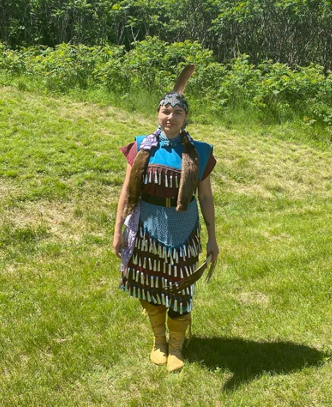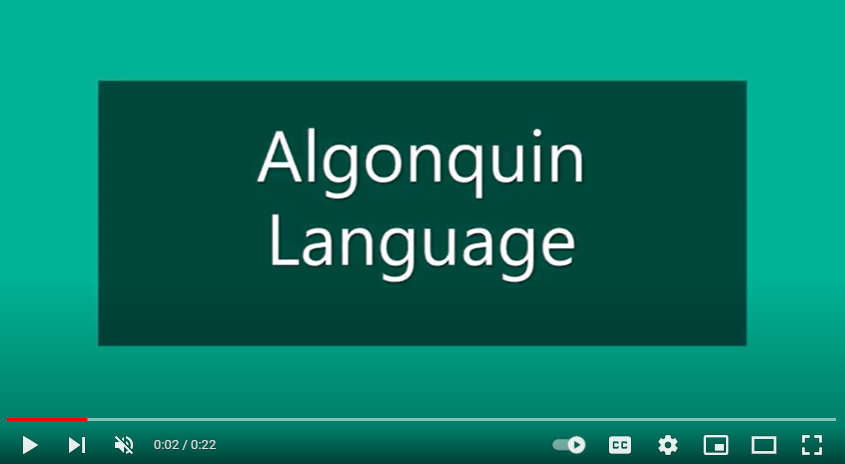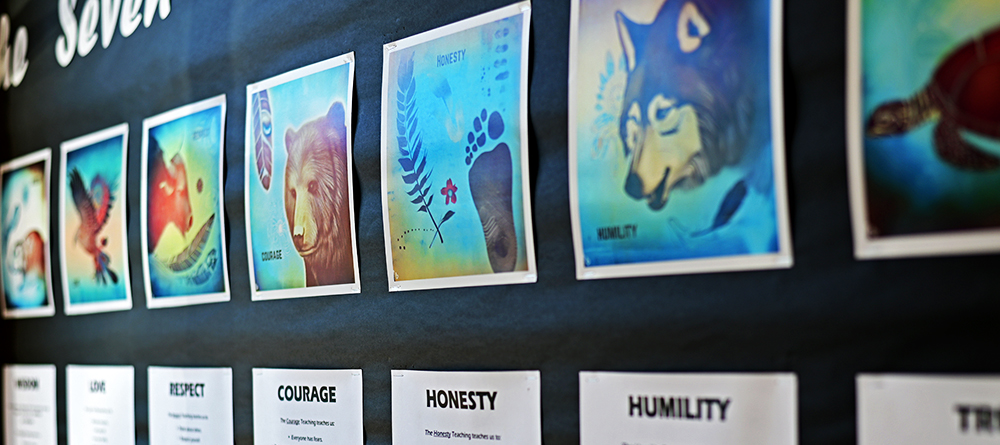The content of this page was prepared, updated, and featured throughout the month of June 2021. This page will now most likely stay relatively dormant until June 2022.
Indigenous History matters year-round. Below are tons of interesting and important learning resources to explore.
It looks like you’re using a small device to view this page. We suggest you rotate it sideways.
National Indigenous History Month 2025
Banner credit, Government of Canada 2024: an eagle representing First Nations, a narwhal representing Inuit and a violin representing Métis. These illustrations are placed around the sun and surrounded by multicoloured smoke that represents Indigenous traditions, spirituality, inclusion and diversity. https://www.rcaanc-cirnac.gc.ca/
Statement from the Western Québec School Board
The Western Québec School Board acknowledges that the lands upon which we live, learn, play, and work are on the traditional unceded territory of the Algonquin Anishinaabe peoples. We thank the Algonquin people for sharing these lands and commit, as an organization and as individuals, to an ongoing relationship that recognizes and respects the lands, traditions, and culture of the Algonquin Anishinaabe people.
We recognize the importance of honouring the cultures and traditions of the hundreds of First Nation communities in Canada. We recognize and value the experiences, cultures, and traditions of our Indigenous communities. We are committed to listening, responding, supporting, and working together with our students, families, and communities.
Book Lists
Our library team at the Western Québec School Board has curated book lists and online resources for educators in celebration of National Indigenous History Month. We leave you to enjoy, be inspired, and share the following resources.
Non-Fiction
Fiction
Non-Fiction
Fiction
- Rock Your Mocs, by Laurel Goodluck
- When The Stars Came Home, by Brittany Luby
- The Song That Called Them Home, by David A. Robertson
- We Love You as Much as The Fox Loves Its Tail, by Masiana Kelly
- You Are Sacred, by Sarah-Anne Tourond
- Berry Song, by Michaela Goade
- Beautiful You, Beautiful Me, by Tasha Spillett-Sumner
- We All Play, by Julie Flett
- We Are Water Protectors, by Carole Lindstrom
- It’s a Mitig!, by Bridget George
- Tanna’s Owl, by Rachel Qitsualik-Tinsley
- Awâsis and the World-Famous Bannock, by Dallas Hunt
- The Origin of Day and Night, by Paula Ikuutaq Rumbolt
- Once in a Blue Moon, by Danielle Daniel
- Nimoshom and His Bus, by Penny M. Thomas
- When We Were Alone, by David A. Robertson
- I Hope, by Monique Gray Smith
- Biindigen! Amik Says Welcome, by Nancy Cooper
- Remember, by Joy Harjo
- My Powerful Hair, by Carole Lindstrom
- Peace Dancer, by Roy Henry Vickers
- Benny the Bananasaurus Rex, by Sarabeth Holden
Non-Fiction
- Nutshimit, by Melissa Mollen Dupuis
- Keepunumuk: Weeâchumun’s Thanksgiving Story, by Danielle Greendeer, Anthony Perry, and Alexis Bunten
- The Secret Pocket, by Peggy Janicki
- Finding My Dance, by Ria Thundercloud
- Indigenous Life in Canada series from Beech Street Books, https://www.beechstreetbooks.ca/imprint/coast2coast2coast/WBEE0009
- Indigenous Nations in North America from Beech Street Books, https://www.beechstreetbooks.ca/imprint/new/WBEE0071
- National Day for Truth and Reconciliation, by Dawn Smith
- Indigenous People and Climate Change, by Marla Tomlinson
- Contenders: Two Native Baseball Players, One World Series, by Traci Sorell
- Autumn Peltier, Water Warrior, by Carole Lindstrom
- The Water Walker, by Joanne Robertson
- Freddie the Flyer, by Fred Carmichael
- The Mothers of Xsan series, by Hetxw’ms Gyetxw (Brett D. Huson)
- Fry Bread: A Native American Family Story, by Kevin Noble Maillard
Fiction
- The Misewa Saga, by David A. Robertson (book 5 coming soon!)
- Weird Rules to Follow, by Kim Spencer
- Mascot, by Charles Waters and Traci Sorell
- Ancestor Approved: Intertribal Stories for Kids, edited by Cynthia Leitich Smith
- Aggie & Mudgy: The Journey of Two Kaska Dena Children, by Wendy Proverbs
- Bernice and the Georgian Bay Gold, by Jessica Outram
- The Case of Windy Lake, by Michael Hutchinson – Book One of the Mighty Muskrat Mystery series
- Elvis, Me, and the Lemonade Stand Summer, by Leslie Gentile
- Forever Birchwood, by Danielle Daniel
- I Can Make This Promise, by Christine Day
- Healer of the Water Monster, by Brian Young (book one of the series)
- Peacemaker, by Joseph Bruchac
- Rez Dogs, by Joseph Bruchac
- Race to the Sun, by Rebecca Roanhorse
- The Storyteller, by Brandon Hobson
- Eagle Drums, by Nasuġraq Rainey Hopson
- Sisters of the Neversea, by Cythina Leitich Smith
- The Ghost Collector, by Allison Mills
Non-Fiction
- Tales from Big Spirit graphic novel series, by David A. Robertson
- The Witness Blanket, by Carey Newman and Kirstie Hudson
- Everything You Wanted to Know About Indians But Were Afraid to Ask, Young Readers Edition, by Anton Treuer
- How I Survived Four Nights on the Ice, by Serapio Ittusardjuat
- Righting Canada’s Wrongs series books The Sixties Scoop, Inuit Relocations, and Residential Schools
- Truth Telling: Seven Conversations About Indigenous Life in Canada, by Michelle Good
- Braiding Sweetgrass for Young Adults, by Robin Wall Kimmerer, adapted by Monique Gray Smith
- Turtle Island: The Story of North America’s First People, by Eldon Yellowhorn and Kathy Lowinger
- #NotYourPrincess: Voices of Native American Women, by Lisa Charleyboy and Mary Beth Leatherdale
- The Power of Style: How Fashion and Beauty Are Being Used to Reclaim Cultures, by Christian Allaire
- Treaty Words: For As Long As the Rivers Flow, by Aimée Craft
- Living Ghosts and Mischievous Monsters: Chilling American Indian Stories, by Dan SaSuWeh Jones
Fiction
- Warrior Girl Unearthed, by Angeline Boulley
- Saints of the Household, by Ari Tison
- A Snake Falls to Earth, by Darcie Little Badger
- Funeral Songs for Dying Girls, by Cherie Dimaline
- Harvest House, by Cynthia Leitich Smith
- Walking in Two Worlds, by Wab Kinew
- Surviving the City series, by Tasha Spillett
- The Rez Doctor, by Gitz Crazyboy
- Looking for Smoke, by K.A. Cobell
- Borders, by Thomas King
- Rez Ball, by Byron Graves
- Those Pink Mountain Nights, by Jen Ferguson
- This Place: 150 Years Retold, by Kateri Akiwenzie-Damm
- Four Faces of the Moon, by Amanda Strong
- Apple in the Middle, by Dawn Quigley
- If I Ever Get Out of Here, by Eric Gansworth
- Burning Cold, by Rachel Qitsualik-Tinsley
- Fire Song, by Adam Garnet Jones
- The Secret Path, by Gord Downie
Resources for Educators
- Native Land Digital: https://native-land.ca/
- Whose Land: https://www.whose.land/en/lesson-plans (Land Acknowledgement PD & Lesson Plans, and more)
- National Centre for Truth and Reconciliation: https://nctr.ca/records/reports/#trc-reports
- Assembly of First Nations: https://education.afn.ca/afntoolkit/learning-modules/
- Walk for Wenjack: https://downiewenjack.ca/our-work/walk-for-wenjack/
- IBBY Canada: https://www.ibby-canada.org/indigenous-picture-book-collection/
- Strong Nations: https://www.strongnations.com/store/item_list.php?it=1&cat=2753
- Good Minds: https://goodminds.com/
- The Indigenous People’s Atlas of Canada: https://indigenouspeoplesatlasofcanada.ca/
- University of Alberta MOOC, Indigenous Canada: https://www.ualberta.ca/admissions-programs/online-courses/indigenous-canada/index.html
- The Witness Blanket: https://witnessblanket.ca/
- National Film Board: https://www.nfb.ca/search/?q=indigenous&cat=films&language=en&sortBy=relevance&orderBy=desc
- The Canadian Encyclopedia, Josephine Mandamin: https://www.thecanadianencyclopedia.ca/en/article/josephine-mandamin (see The Water Walker above)
- Carleton Newsroom, Celebrating Indigenous History Month as an Ally: https://newsroom.carleton.ca/story/indigenous-history-month-ally/
- Canadian Museum of History: https://www.historymuseum.ca/national-indigenous-history-month/
- Canadian Human Rights Museum: https://humanrights.ca/story/what-two-spirit-part-one-origins
- CBC Kids News: https://www.youtube.com/watch?v=2tfpswUBezM
- Government of Canada, National Indigenous History Month: https://www.rcaanc-cirnac.gc.ca/eng/1466616436543/1534874922512
- The Western Québec School Board’s Maniwaki Woodland School shares an introduction to the Algonquin language: https://www.youtube.com/watch?v=4pDUCKob714
- The Western Québec School Board’s Consultant for Indigenous Pedagogy and Maniwaki Woodland teacher Drew Wapachee McDougall, a member of Kitigan Zibi, shares what the Pow Wow means to her: https://westernquebec.ca/what-are-pow-wows/
- The William Commanda bridge linking Gatineau to Ottawa: https://secure.infc.gc.ca/investments-investissements/stories-histoires/trans-mobil/ottawa-on-eng.html
- The Canadian Encyclopedia, Test your knowledge of Indigenous History: https://www.thecanadianencyclopedia.ca/en/quiz/cc-quiz-indigenous-peoples
Follow us
This page is prepared and updated by the Western Québec School Board, with the help of its community. © 2024 Commission scolaire Western Québec / Western Québec School Board


